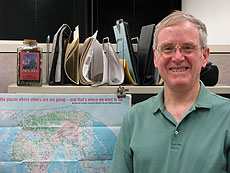Lab organization bolstered by Wehmann’s computing skills
 |
|
Alan Wehmann helped design much of the software for NuMI and keeps a jar of Numi tea in his office as a reminder. Photo: Tona Kunz |
Alan Wehmann was a high school student in 1957 when Russia’s Sputnik satellite made headlines. It stirred his passion for science, and set the trajectory of his career toward physics and landed him at a then-fledgling Fermilab in 1969.
“That first year, the offices were located in Oakbrook,” Wehmann recalled. Excavation of the main ring was still under way at the Batavia laboratory. “You could see the concrete hoops (for the accelerator),” he said.
As the laboratory took shape before his eyes during the last 40 years, Wehmann became known as a man of quiet determination who got the job done.
“He is not a boisterous, look-at-me type individual but rather has kept a low-level, even-keel profile and he let his projects speak volumes for him,” said long-time colleague Paul Czarapata, deputy division head of the Accelerator Division.
This even-keel nature, combined with his computer savvy and organizational skills proved instrumental to the laboratory during the Tiger Team Inspections initiated by the DOE in the 1980’s. Preparation for the inspections created “massive reports“, said Wehmann, who used early computer programs to organize the vast accumulation of information into a useful database.
Soon Wehmann was sought after by many groups and projects to organize their documentation and help with web and doc-db files, Czarapata added.
“For our major projects, NuMI and NoVA, Alan has had an invaluable role in leading efforts to provide the capability and organization for efficient order and usability of the thousands of documents they generate,” said Sam Childress, NuMI operations coordinator.
Wehmann had been on partial retirement recently, and his last official day was Dec.14, 2010. He will continue to work as a guest scientist helping with NOvA and the Education Office’s work with high school students. Wehmann enjoys watching the next generation marvel at today’s science just as he marveled at Sputnik.
“Its pretty mind blowing what the modern kid can be involved in,” he said. “You can really go far if you have that inclination.”
--Rita Hoover
|